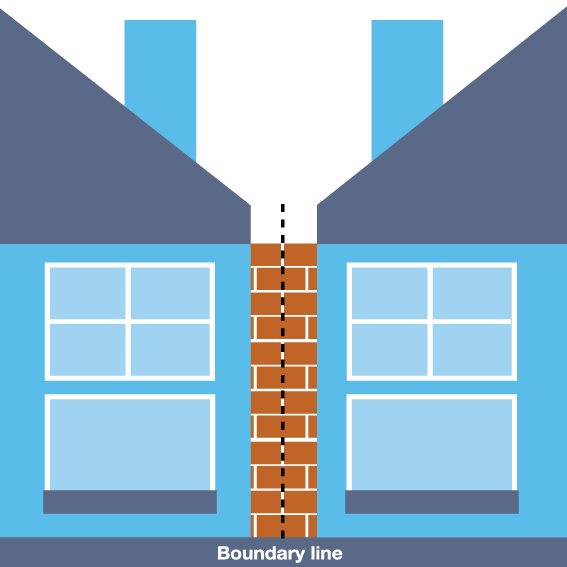All You Need To Know About Extension Party Wall Agreements…

Party Wall Agreements
A Party Wall
Is generally what separates you from the lot next door, or both lots, if you live in a terrace.
Let's Get Specific
But it goes further than that, it doesn’t only have to be a part of both homes, (i.e. if you drilled through it, you could see into your neighbour’s bathroom).
It can also be -
The exterior wall of a detached house that also happens to be the boundary line.
A (common or) garden boundary wall.
A garden boundary wall with a building against it (a detached garage possibly).
The floors and ceilings of adjoining flats.
The process also covers -
Excavations within 3 metres of a neighbouring building where those excavations will be deeper than those of the building. ( i.e. your extension's foundation).
Excavations within 6 metres of a neighbouring building, where those excavation will go below a line drawn 45° downwards from the bottom of the foundations of the neighbouring building. (We’re talking underground car parking here).
The type of work relevant to the procedure is that which might have an effect upon the structural strength of the wall or might cause damage to your neighbour’s side of it.
This includes.
Underpinning.
Demolishing or rebuilding.
Increase its height or thickness.
Insertion of any type of damp proof course.
Cutting into it to take load-bearing beams.
Drilling into it to support structural beams etc (as opposed to putting a shelf up).
The Party Wall Act
Deals with the procedure which must be followed when a homeowner wishes to undertake any of the above.
You should remember that gaining planning permission or complying with the building regulations does not remove the need to comply with the Party Wall Act where it is applicable.
The best and by far the cheapest way to deal with the process is verbally. Speak to your neighbour, explain what is going to happen and get his reaction. If he says he is happy for the work to progress you would be wise to give him a Party Wall Agreement to sign.
Best Course of Action
Agreements are organised between neighbours, there is no need to involve party wall surveyors. In general the agreement should set out a fair and reasonable framework to allow the building work to be carried out quickly and safely without causing any unnecessary inconvenience to the adjoining owner. It also sets out an inexpensive and straightforward procedure for both parties to follow if there are any problems, or damage occurs.
(At the time of writing this article, we found a company of party wall surveyors via the internet, who will provide an agreement specifically customised to your needs, as each job is different, for £99)!
Not Your Work?
If you are “the neighbour” reading this, not the householder undertaking the work, you might like to suggest that a Schedule of Condition is provided for you.
This is a report providing a detailed and accurate report of the condition of your property before work starts.
The schedule of condition serves to protect both parties in the event of a later dispute.
If allegations of damage are made then the schedule of condition makes it easy for the owners to decide between themselves whether the damage came about after the works or existed before the work started.
Even if the owners cannot agree, the schedule of condition is very helpful to any surveyor appointed to investigate the allegation of damage and can help to prove liability.
(You will not be surprised to learn that the same company of party wall surveyors will also provide this, at a cost at the time of writing of £495)!
When All Else Fails
If you have tried and failed with the verbal route, either your neighbour refuses to allow the work, or won’t discuss the matter or doesn’t understand the building process you are proposing, a Party Wall Notice must be issued.
This must be done at least 2 months before the intended start date of the work. It must go to all affected neighbouring parties and must include ………
A clear statement that the notice is being served under The Party Wall etc Act 1996.
The date the notice is being served.
The address of the property where the work is to be undertaken.
The names of the owners.
A brief description of the proposed work.
The proposed start date for the work.
If the notice is for excavation work, then a drawing showing the position and depth of the excavation must be included.
It should also include information regarding what is required of the recipient. ie that they should -
Respond in writing within 14 days of receipt either giving consent or registering dissent. Or make no response, in which case it will be assumed that dissent has been registered.
No Agreement, No Work.
No work may commence until all neighbouring parties have agreed in writing to the notice.
(Our friendly company of party wall surveyors will provide this “notice” and send it to your neighbours for you for £50)!
If the planned work is a new boundary wall up to, or astride the boundary line, the process is similar to the above but the notice needs to be served only one month before the planned start date of the work.
Neighbouring parties must give written agreement within 14 days for walls astride the boundary (or a dispute is deemed to have occurred).
No formal agreement is needed for a wall up to the boundary line, the neighbour just needs not to object in writing.
If the planned work is an excavation within the distance/depth covered by the Party Wall Act, (see above), the notice needs to be served at least one month before the planned start day of the work.
Neighbouring parties must give written agreement within 14 days or a dispute is deemed to have occurred.
What happens if a dispute arises?
If agreement cannot be reached and depending upon whether you are still talking to one another a party wall surveyor or surveyors will have to be involved.
The usual route is:
One surveyor, who is agreed on by both parties, if everything is amicable. Two surveyors if you hate each other.
Either way, (they will talk to each other) a Party Wall Award will be produced and if there are two of them they will also decide who is to pay their fees.
This is usually the party undertaking the work unless the neighbour has involved his surveyor completely unnecessarily.
The award will deal with the right to execute the party wall works, the time and manner of executing that work, and any other matter that arises between the parties connected to the works. In all normal circumstances the party wall surveyor(s) will prepare a Schedule of Condition report of the neighbouring property before works start in order to protect the interests of both parties in the event of a later claim for damages.
Once an Award has been made, all parties have 14 days to appeal to a County Court against it if they so wish.
Sometimes, you've got to bite the bullet..
Once you have agreement, all work must comply with the notice. All the agreements should be retained to ensure that a record of the granted permission is kept.
Any subsequent purchaser of either property may wish to establish that the work was carried out in accordance with the Party Wall Act requirements.
After reading that lot, you may just decide to make do with a nice summer house!
For all job costs click on the appropriate section below:
www.buildingsheriff.com
Copyright The Building Sheriff Ltd 2019


